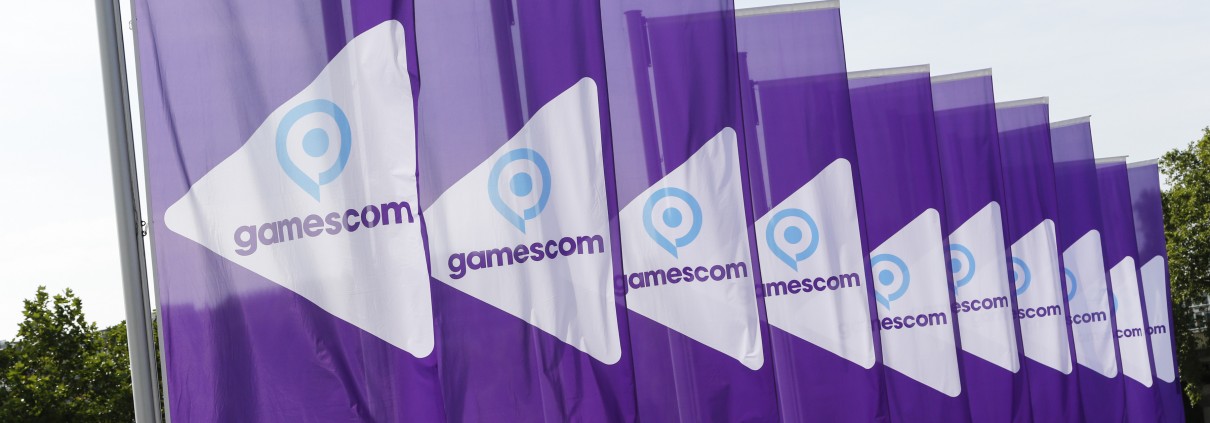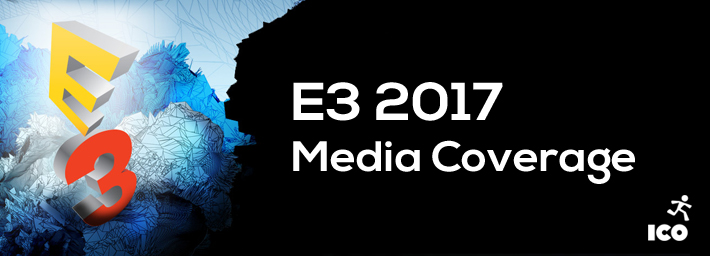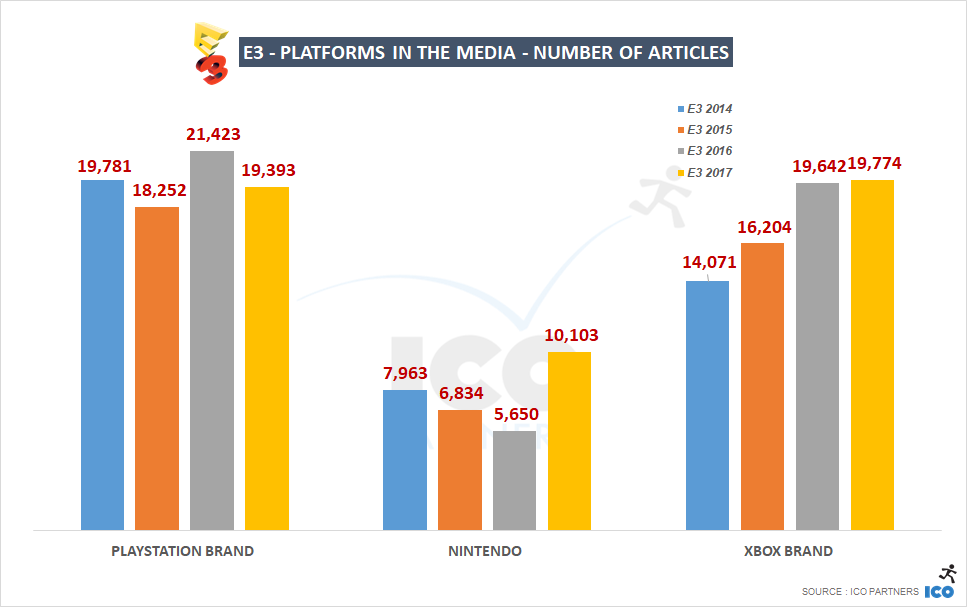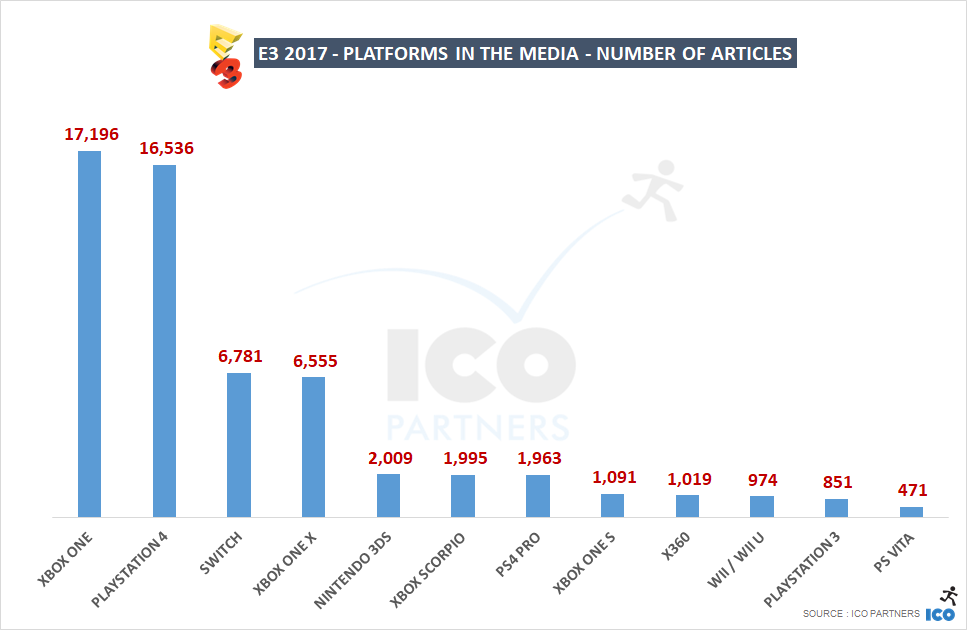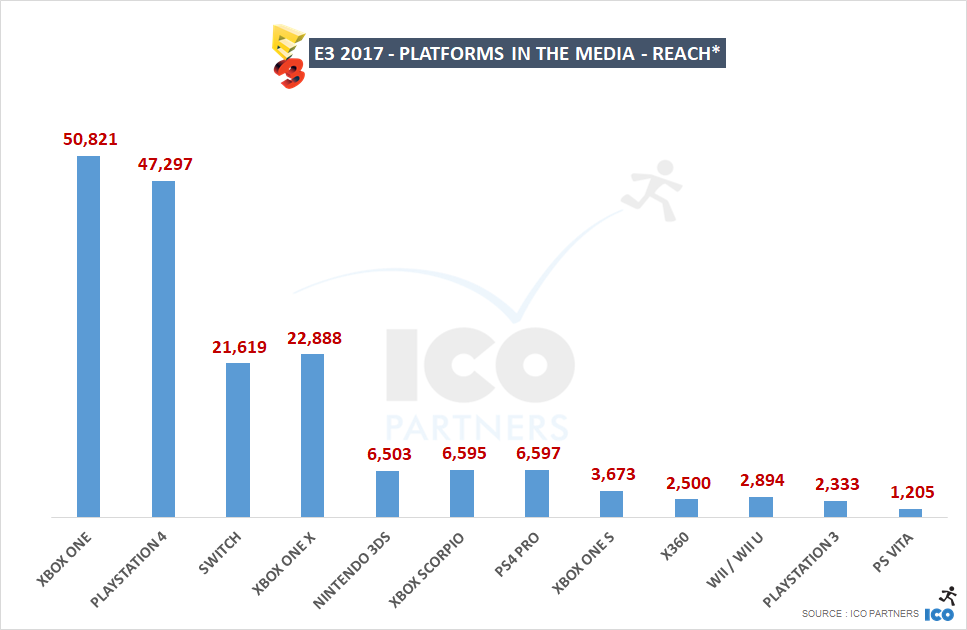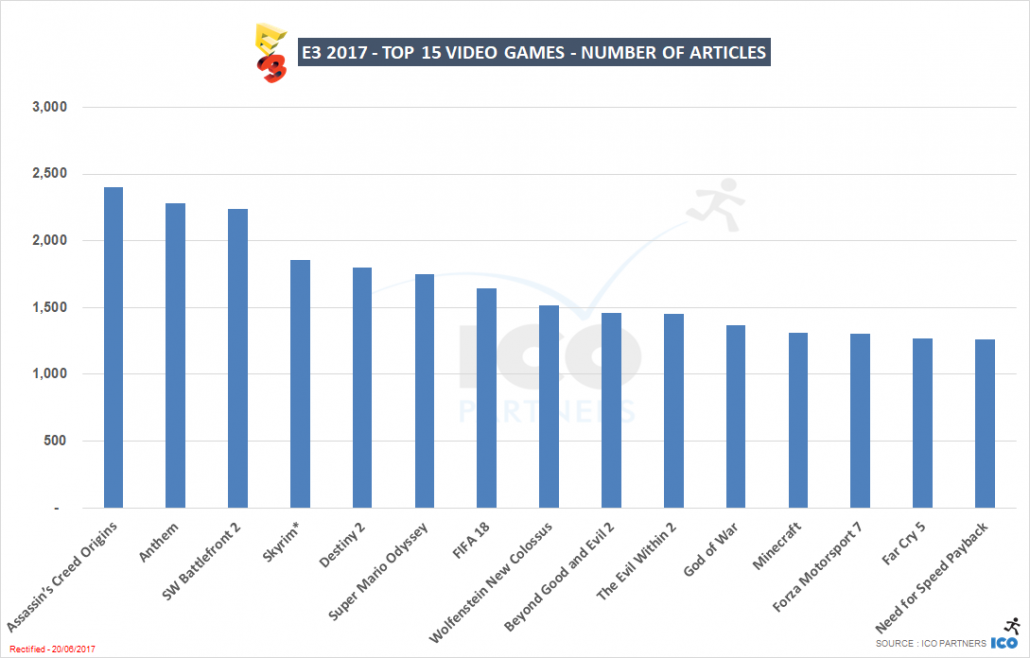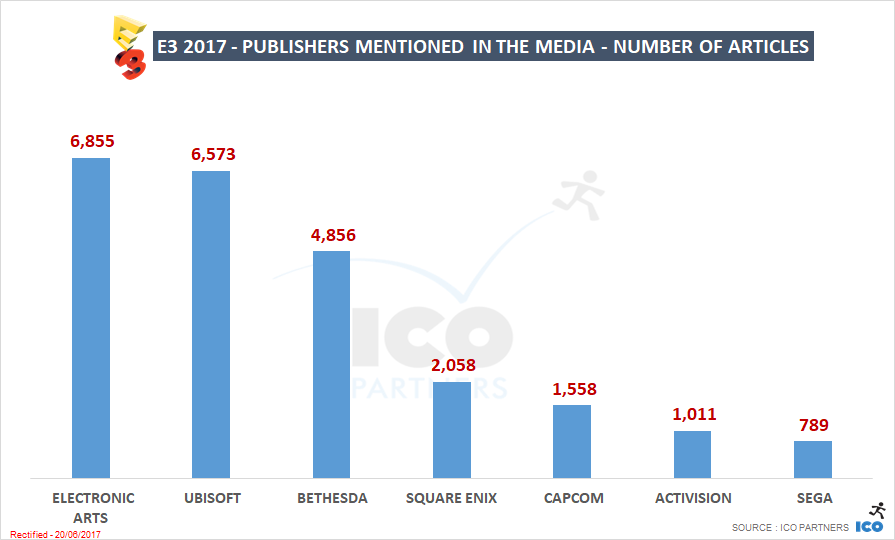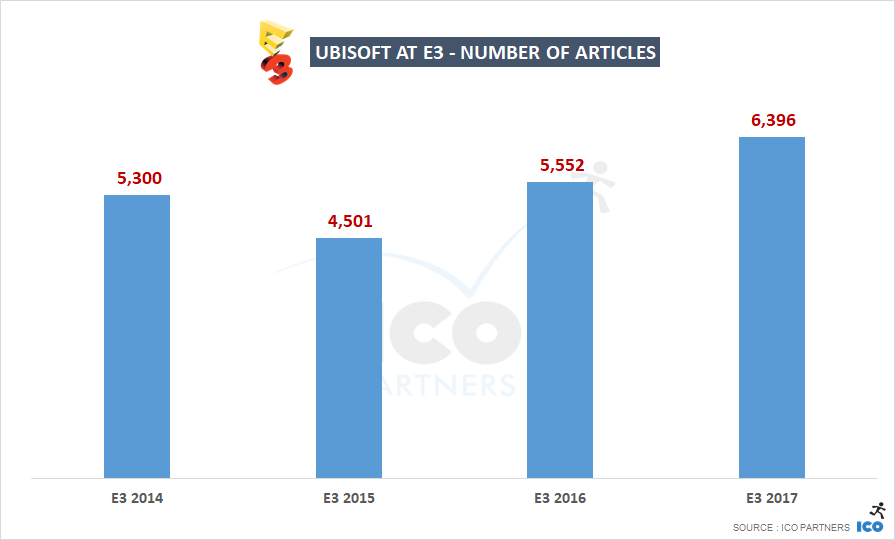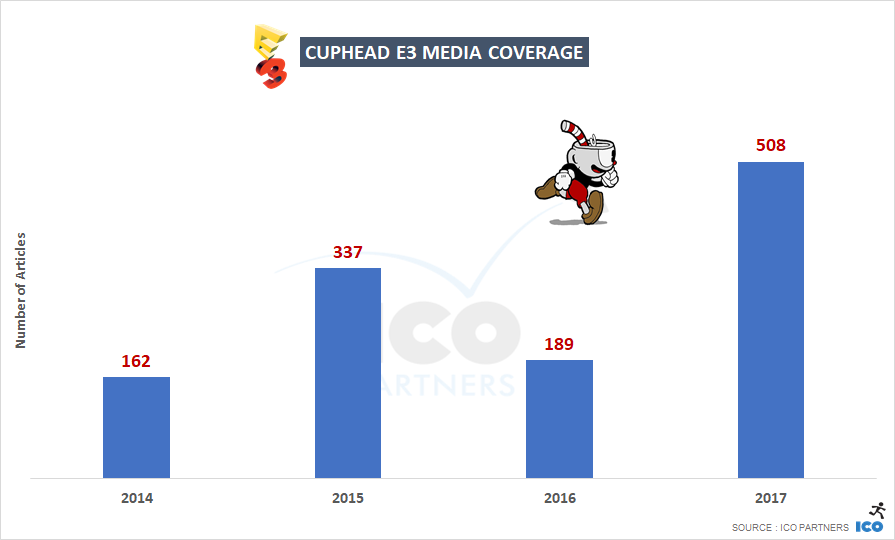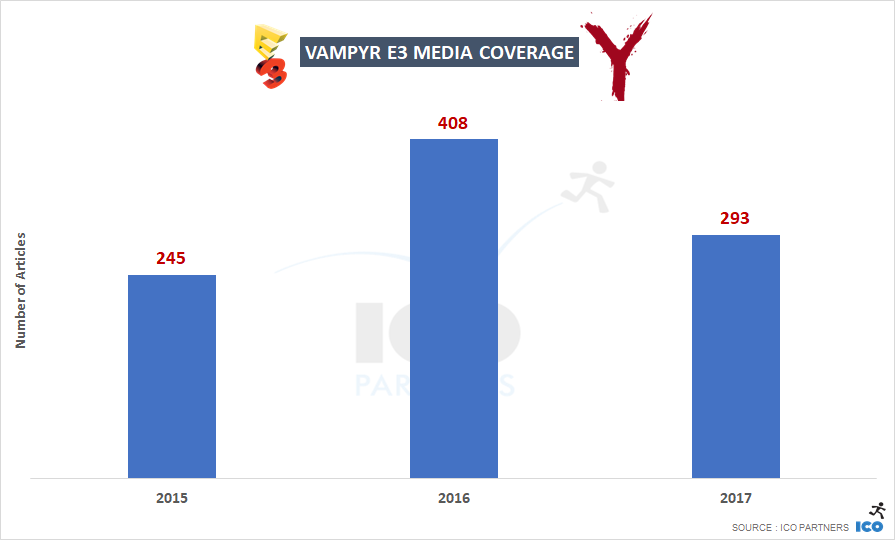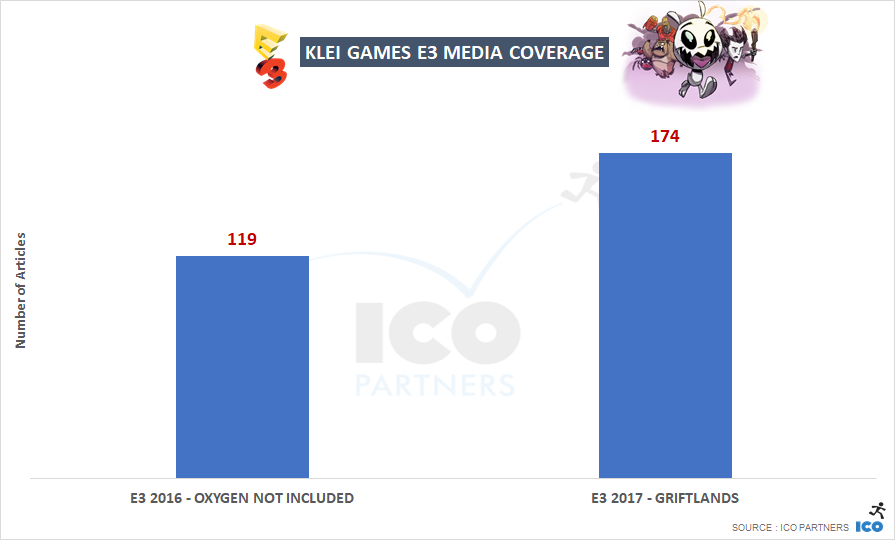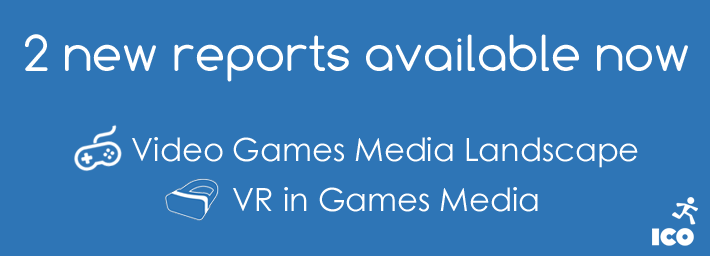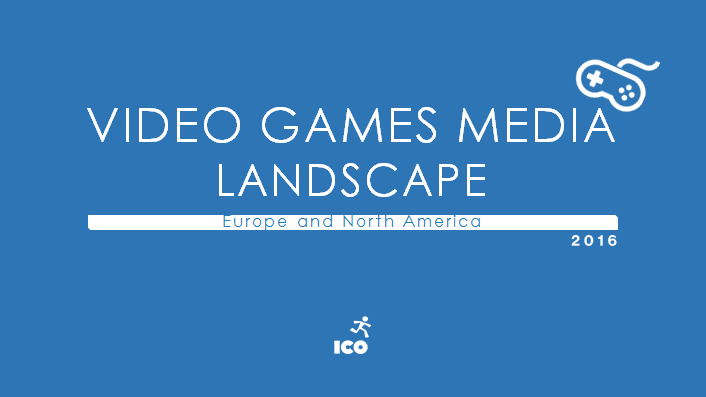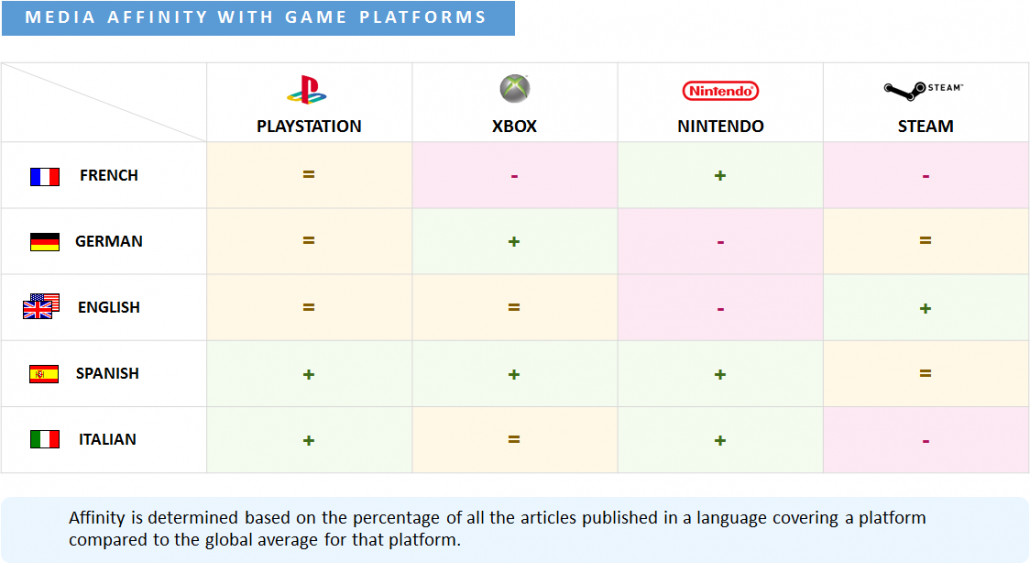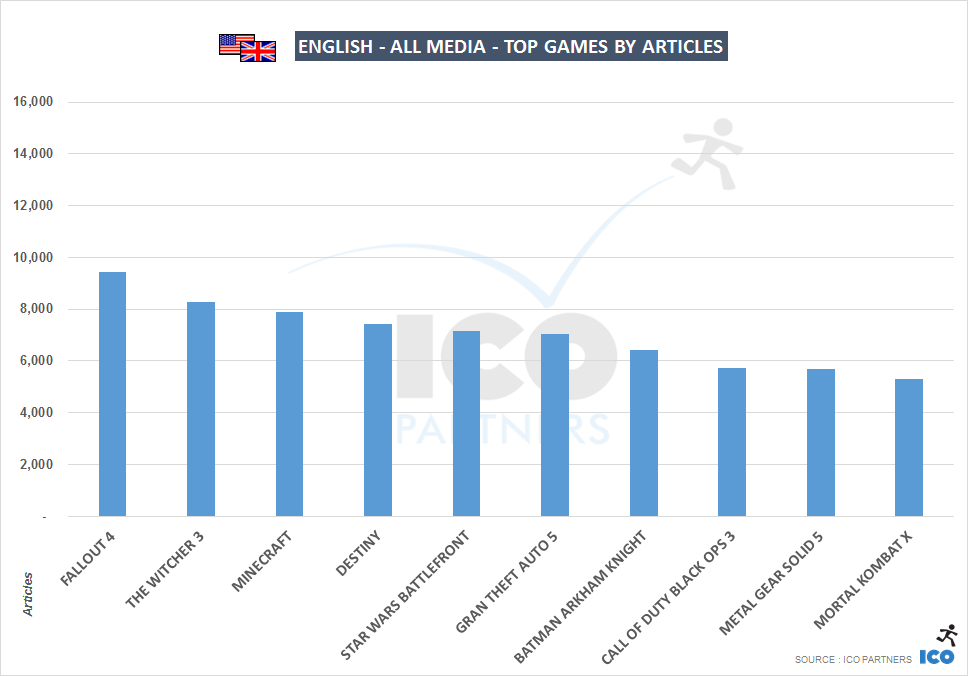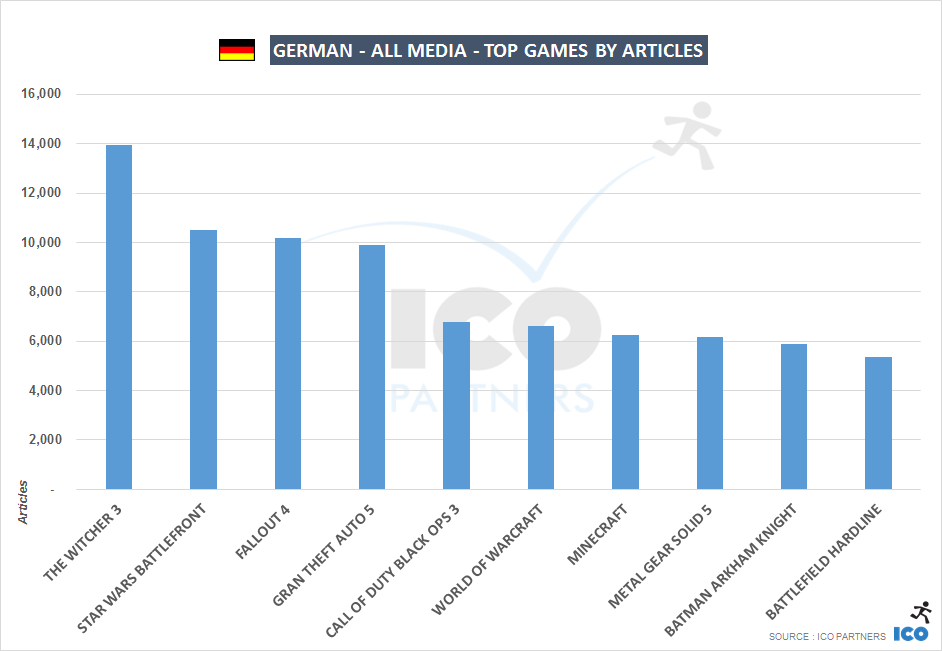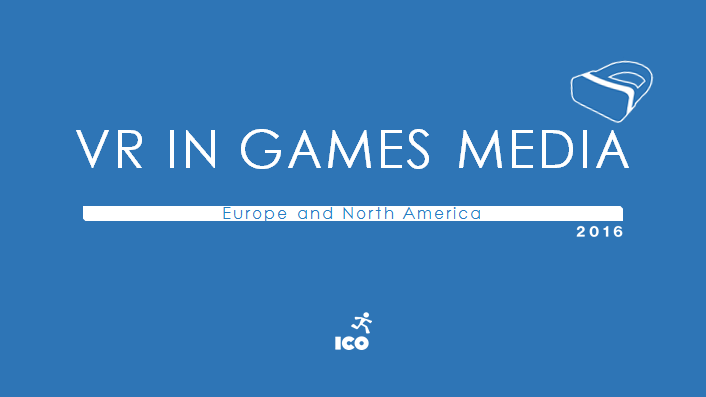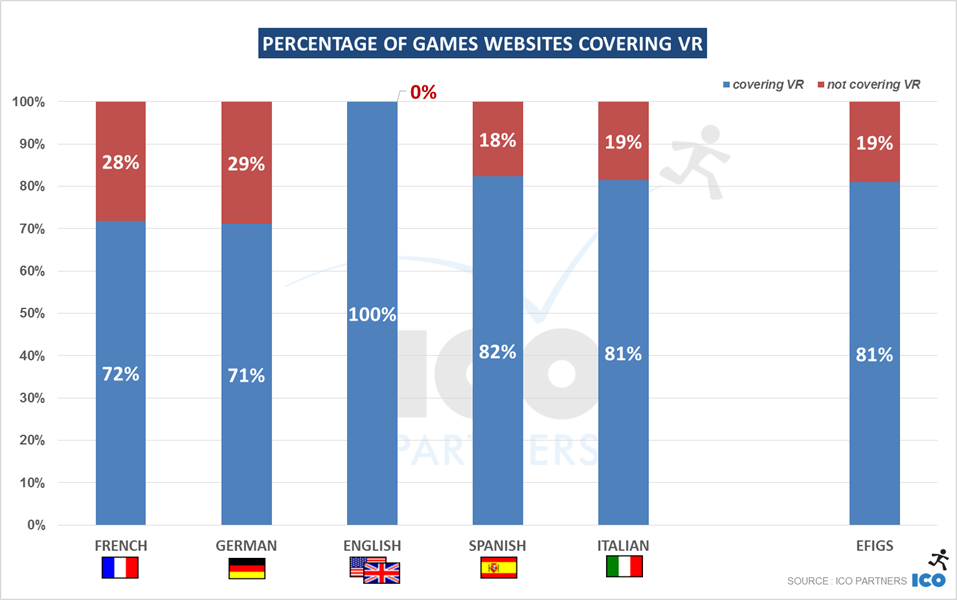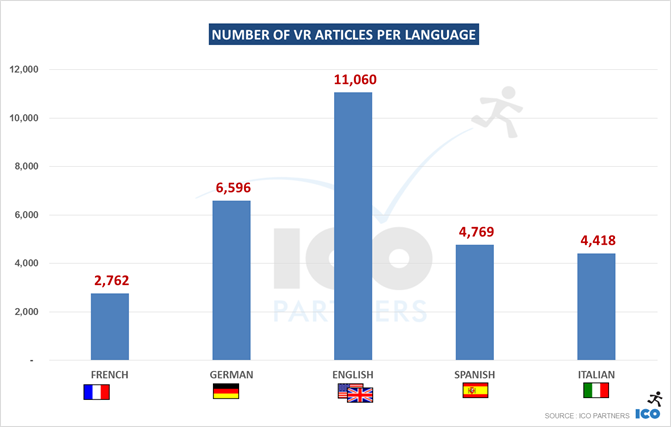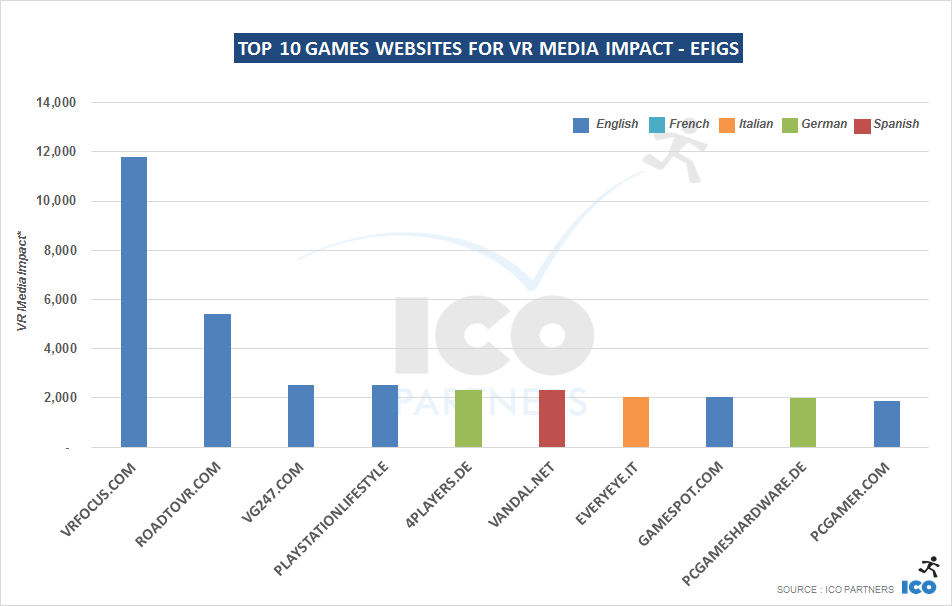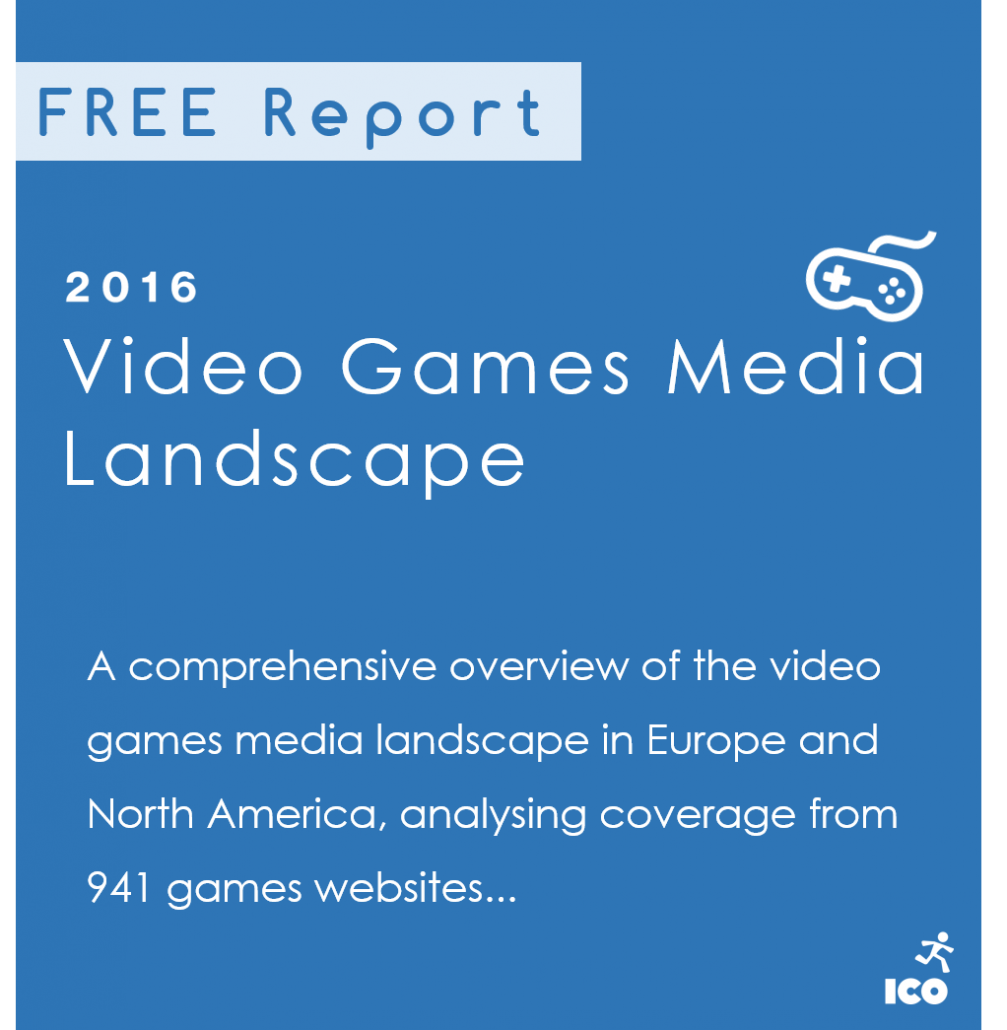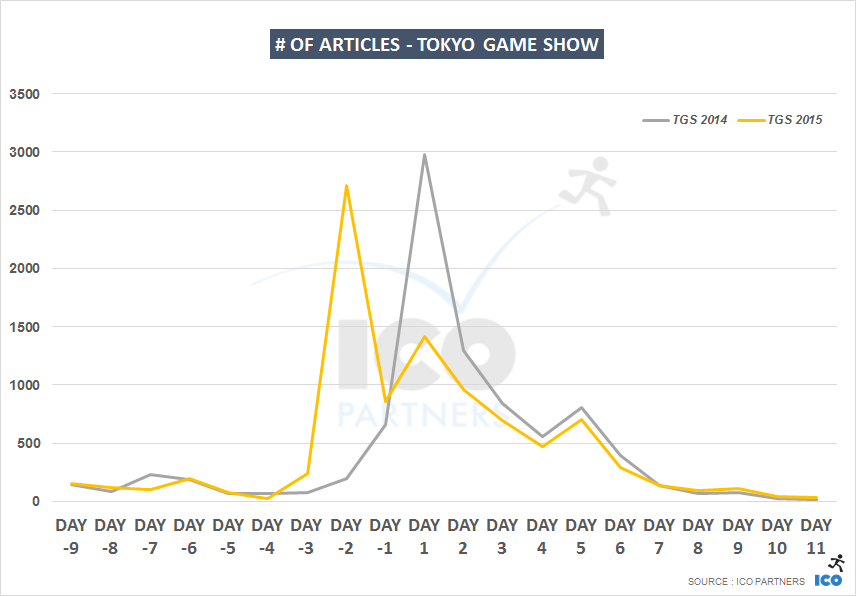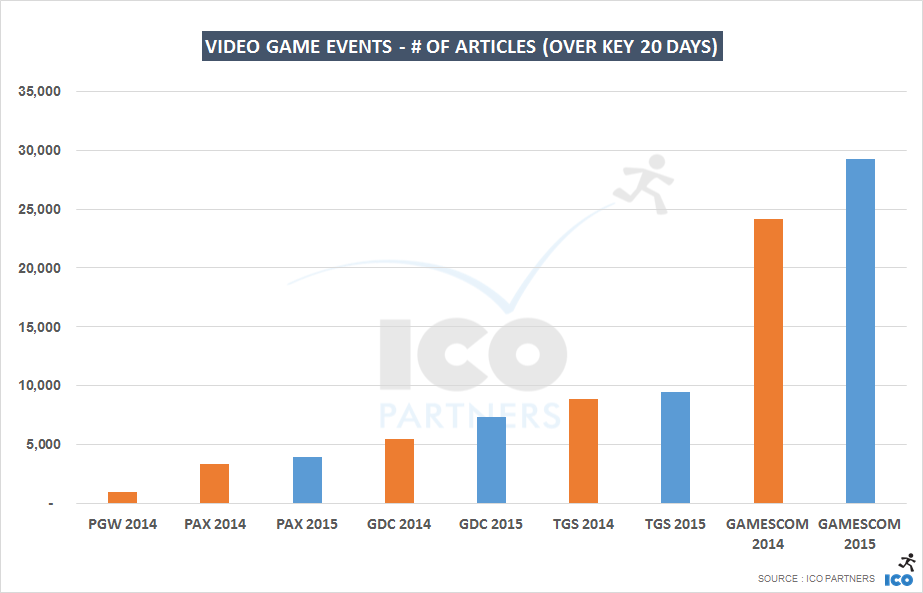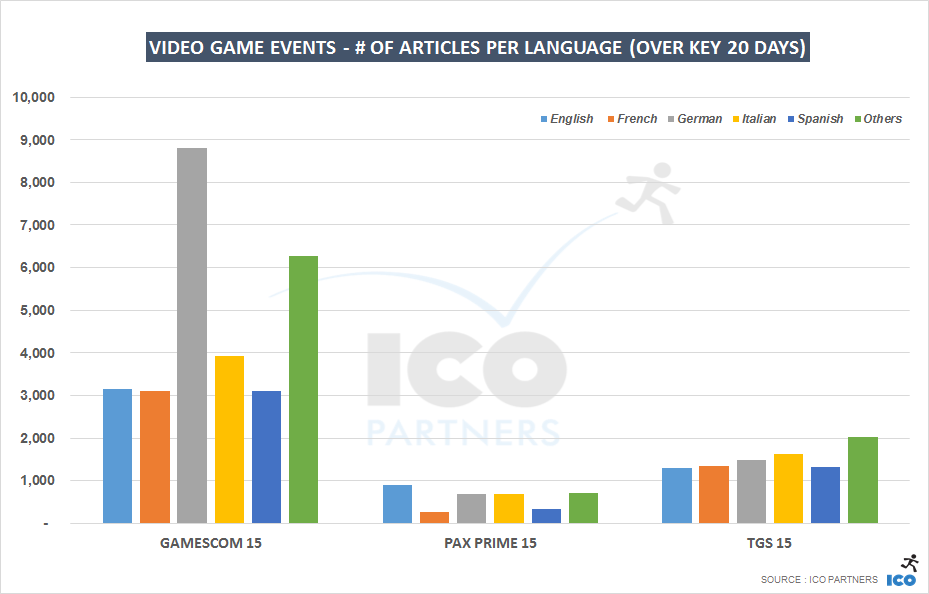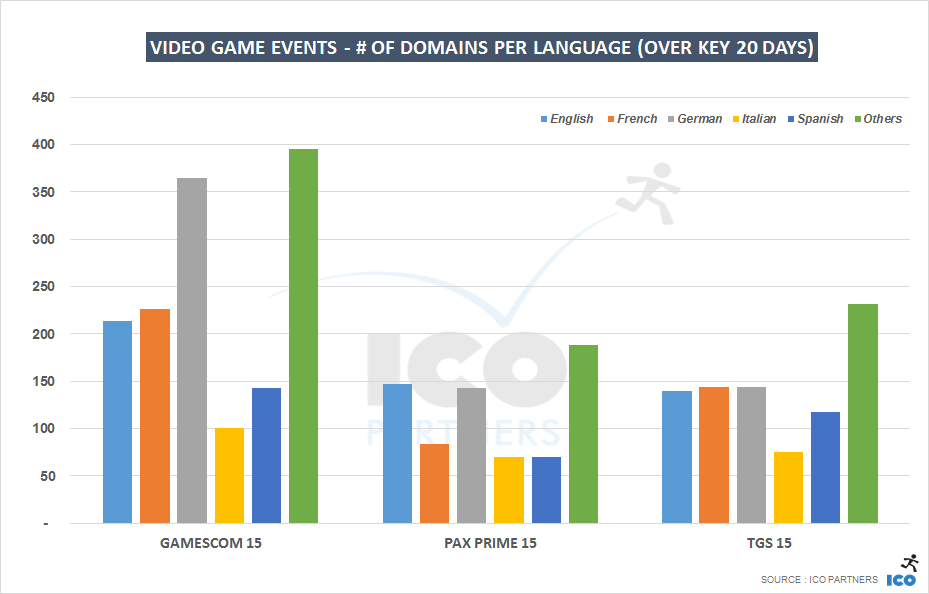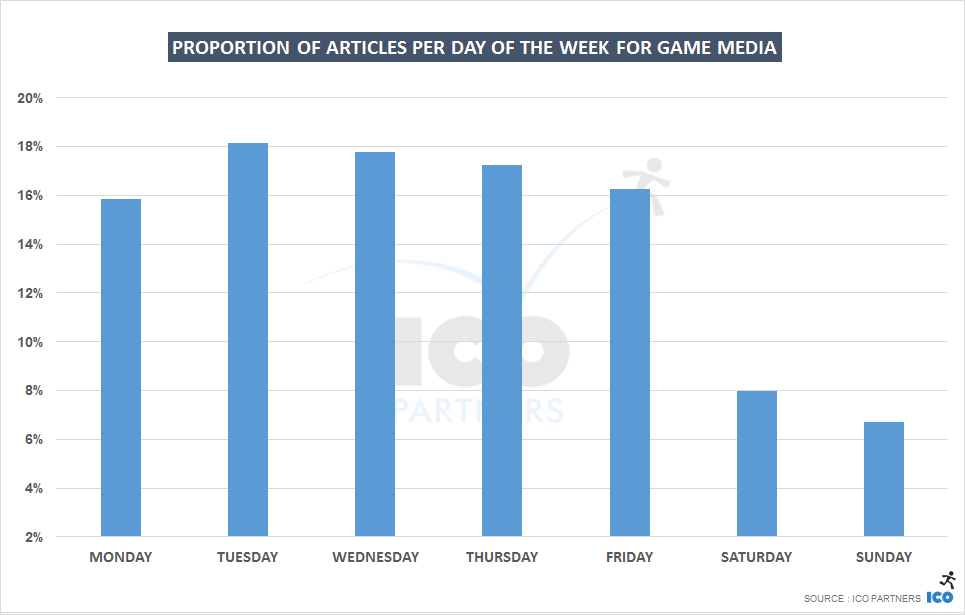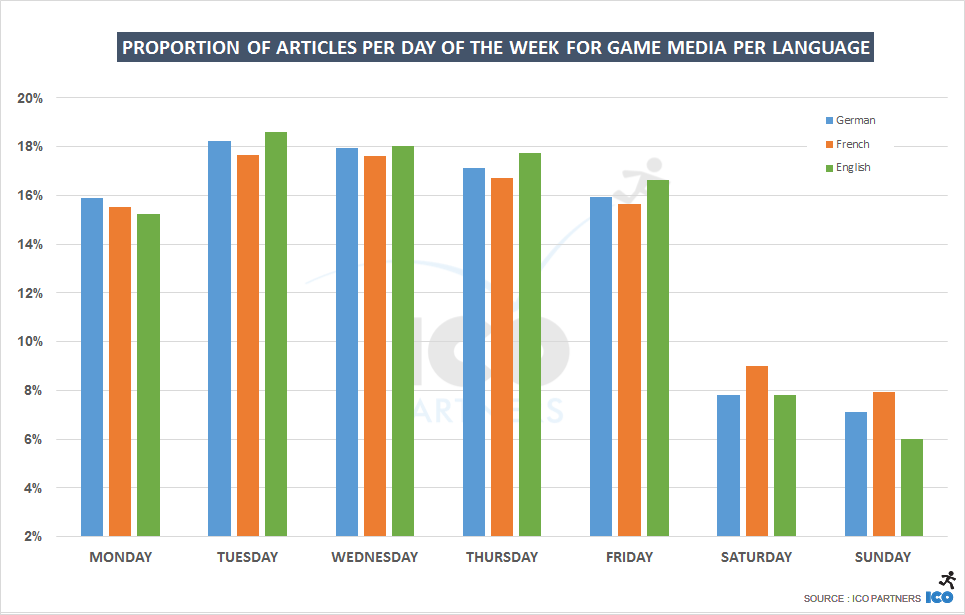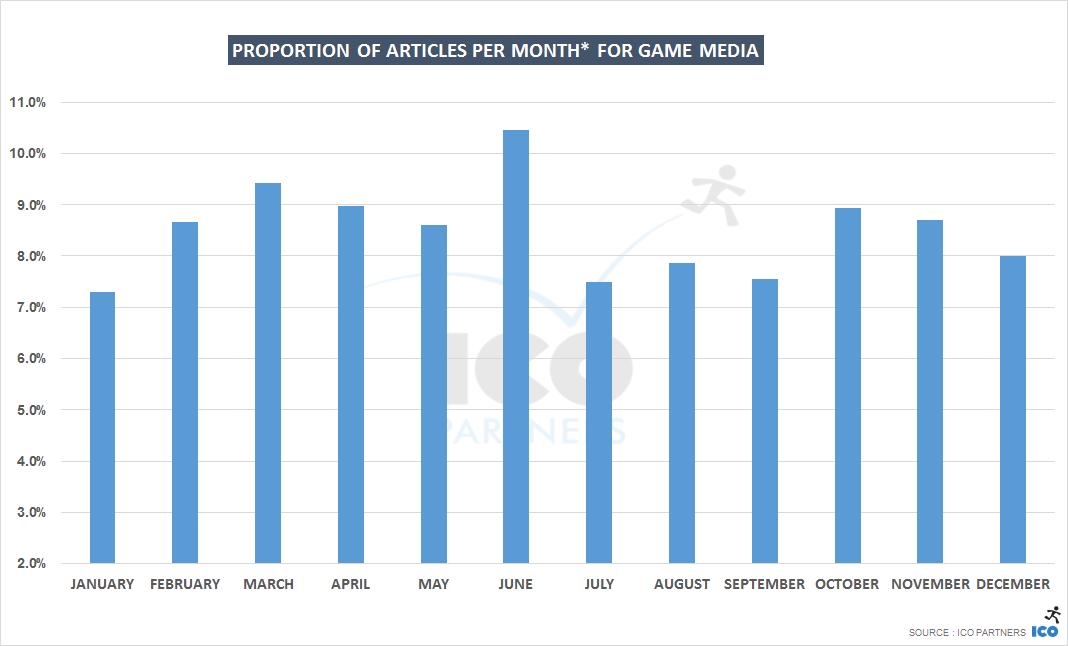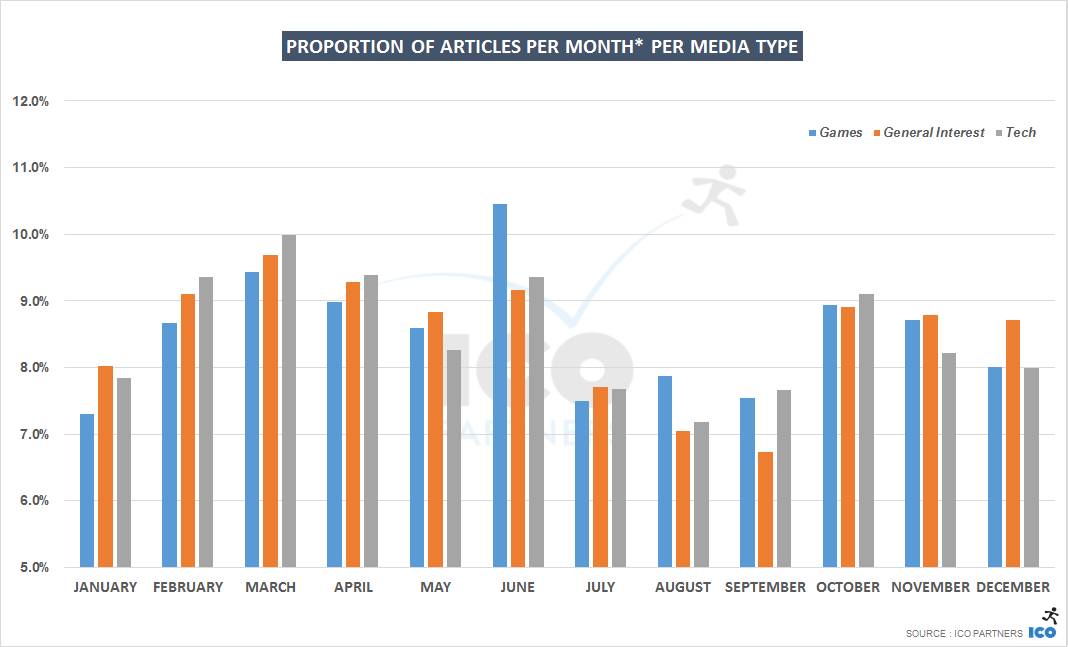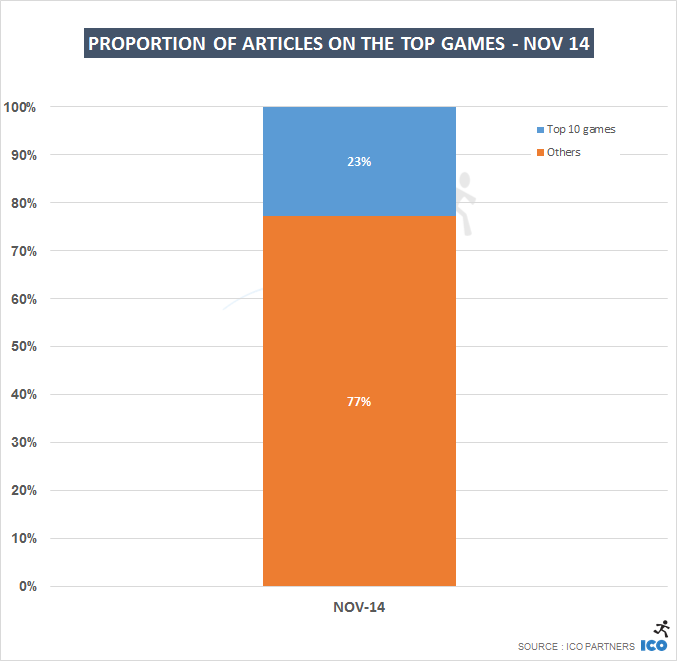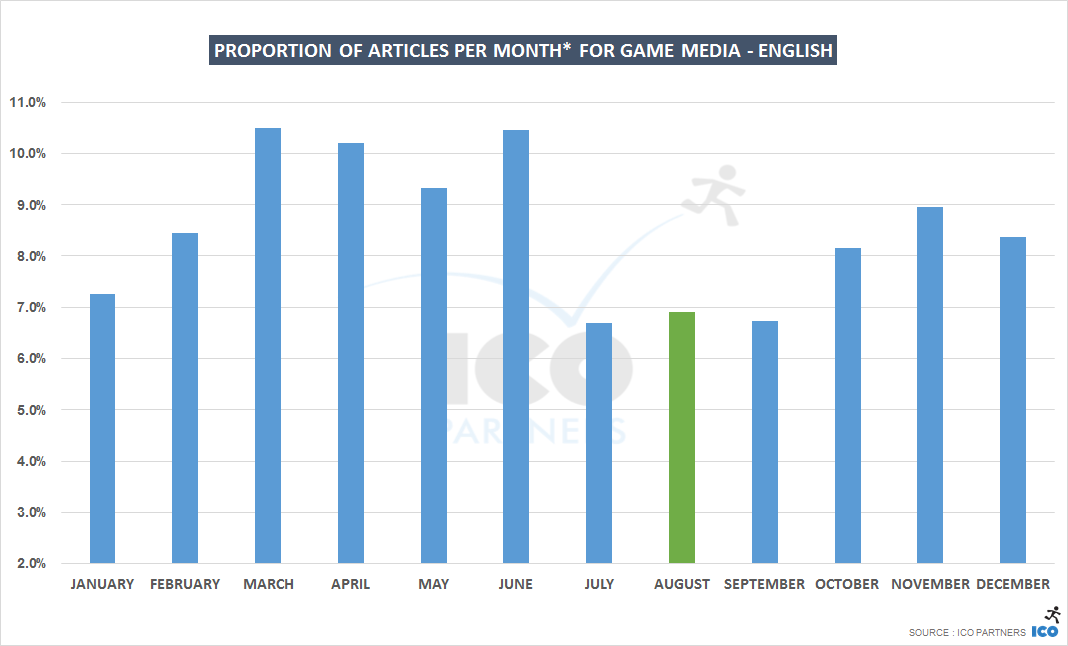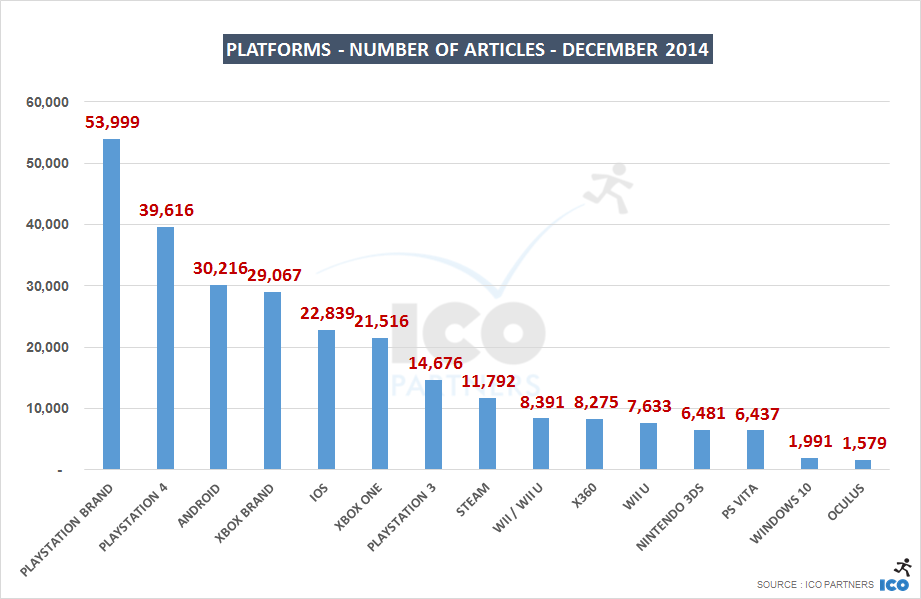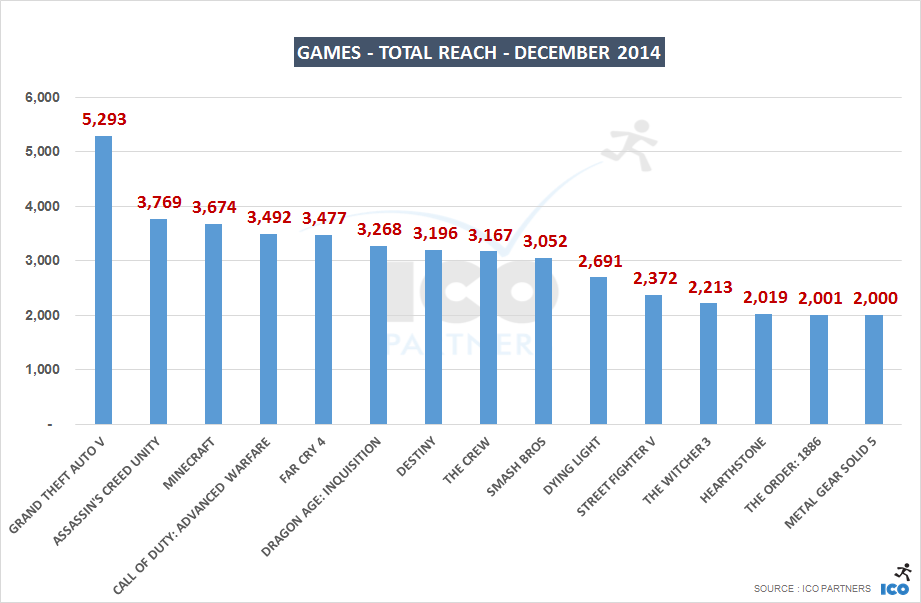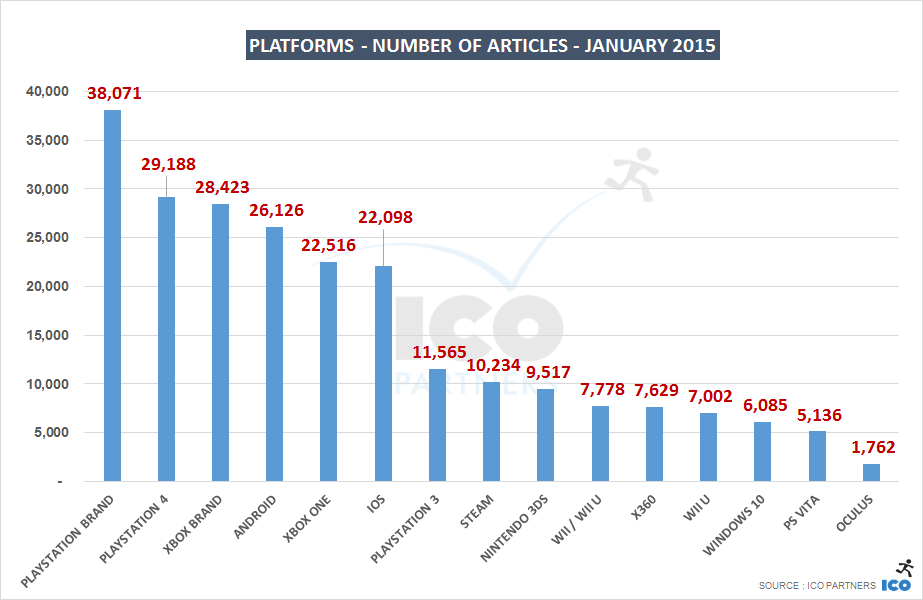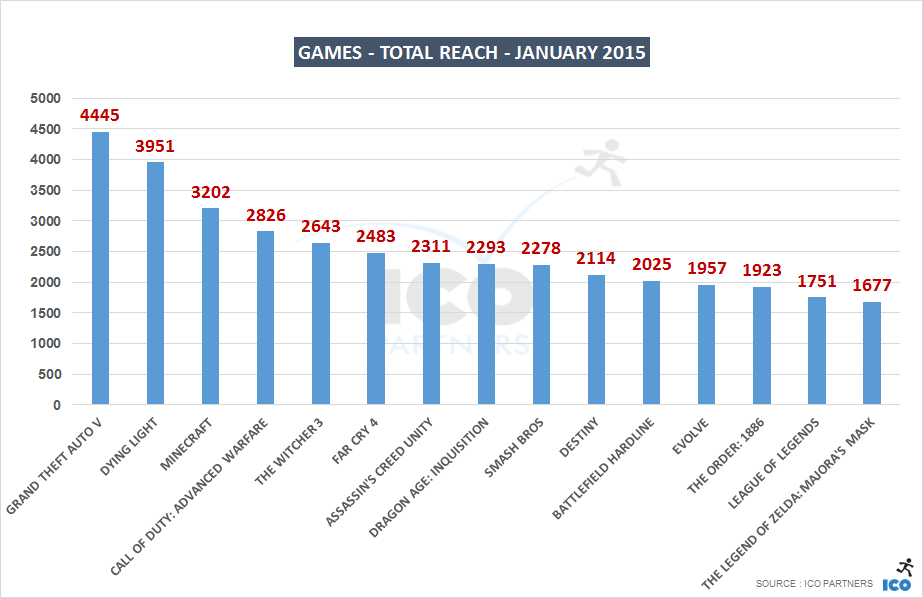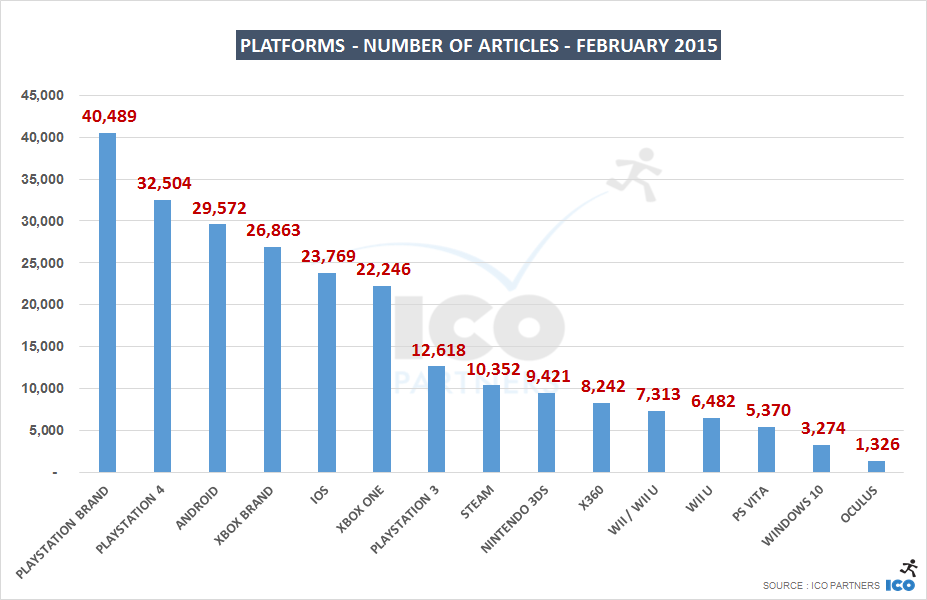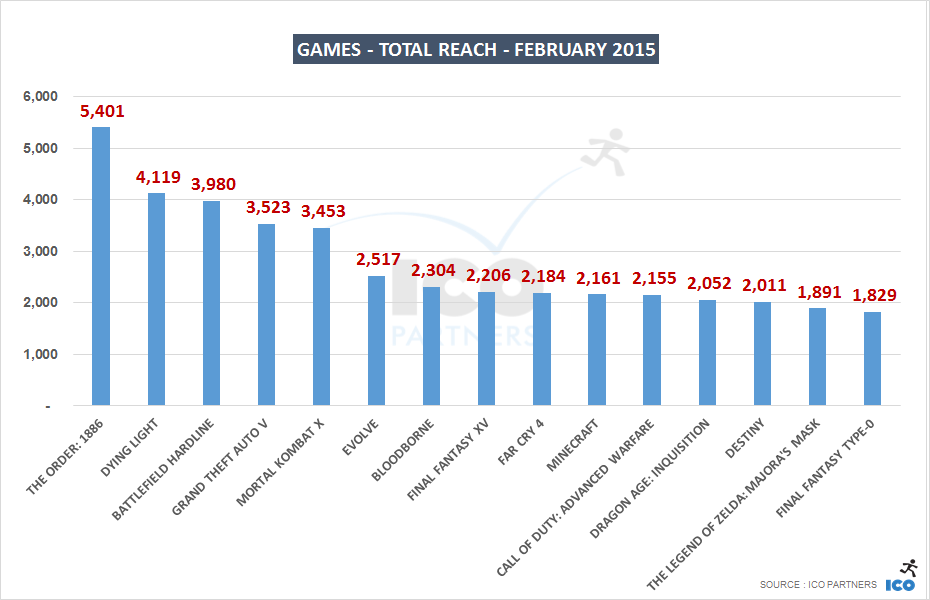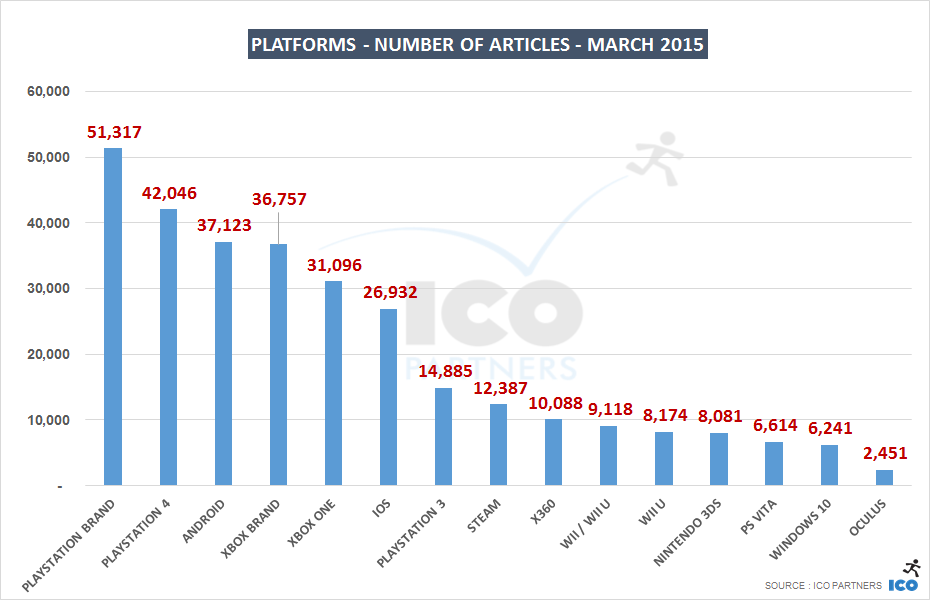This is the yearly look at what is the most important game event in Europe, and the coverage it has generated around its latest edition. Read more
Posts
[EDIT – the dataset initially used didn’t properly cover the articles published on the 10th of June, making the EA coverage much lower than it should be. I have replaced the following graphs: Top 15 Games; Publishers Conferences Compared; Publishers in the Media]
It’s that time of year again: the week after E3, and time for me to go over the numbers and media coverage from the show, as per tradition. If this the first time for you, please fee free to have a look at the methodology used, and read the blog posts for 2015 and 2016.
Platforms
First, looking at the biggest players at E3, the console manufacturers, in many ways this was an interesting year in light of their performance at previous E3’s.
For the first time since we started measuring media coverage at E3 in 2014, Sony is not leading. It has to be said that the gap between them and Microsoft is very small, but this comes on the back of Microsoft growing for the 4th year in a row, and where Sony had its 3rd best performance out of 4 companies (on the back of its best performance last year).
Nintendo, on the other hand, has had its best E3, doubling the coverage they got last year. The Switch is clearly a commercial success and is also popular with the media. With a smaller lineup than its competitors, it is quite the performance for them. The wider 3rd party program, with Ubisoft’s partnership at the forefront, is likely a significant contribution.
Like last year, I created a Google Spreadsheet to list all the announcements done at E3’s press events – feel free to have a look for your own analysis of the lineup announced for each company:
https://twitter.com/icotom/status/874684542220722176
Personally, here are my thoughts on the 3 manufacturer press events:
- Microsoft. It was their best E3 conference to date, as far as I am concerned. They finally hit the right tone in their announcements. However, nothing they have announced is really pushing the Xbox consoles over their competitors. Not many exclusives that would drive someone to pick an Xbox over anything else. The Xbox One X, if anything, is a console for the convinced customer, the one already in the ecosystem.
- Sony. The conference wasn’t mind-blowing, and the media coverage reflects this, but I think Sony was just playing it safe. There have been enough PlayStation exclusives to come out ahead of the show to allow them to message the console as the better alternative in terms of catalogue. The numerous VR games shown was a great reminder of the PlayStation VR, a strong differentiator when compared to other consoles. My biggest issue with the event was the format. It was hard to understand if the pre-show was meant to be considered as part of the main event – and many of the more interesting projects were revealed there. I will also note that during the show, the dates of this year’s PlayStation Experience were announced. This is a strong message that PSX is becoming the main press event for Sony, and I wouldn’t be surprised if they’ve held back a number of high-profile announcements.
- Nintendo. The numbers are quite telling – this was the best E3 for Nintendo in years. They were coming off of the back of an excellent launch for the Switch, and announced a number of high-profile games that are coming out very soon for the console. In terms of short-term hype, this was brilliantly executed. I am still somewhat confused by the Pokemon and Metroid Prime 4 announcements – they are likely to hype a core fanbase, and have the risk of setting expectations beyond what is being developed. I find announcements of this type are better done with something to show in order to frame what is being put together. But who knows with Nintendo? They may well knock these titles straight out of the ballpark.
Looking at specific platforms, a few things are interesting to highlight:
The Switch got more coverage than the Xbox One X last week – which is impressive considering the higher profile of the Xbox brand. Also impressive: the 3DS is still getting a decent amount of coverage.
The main point to consider, looking at the reach of each console, is the fact that the Xbox brand seems to be very good at getting covered by higher profile media. The short lead the Xbox One has over the PS4 is translated to a more significant lead in reach. And the Xbox One X, being slightly behind in terms of the number of articles compared to the Switch, sees a significant lead when considering the corresponding reach.
Finally, I wanted to check the VR device coverage, to compare it with last years.
Again, PSVR is leading. But, there were about half as many articles as at last E3. That’s a steep decline, most likely due to the fact that the speculation on VR is now in a different phase, with all the devices on the market and being known quantities.
Games
Like the previous year, I looked at the top games based on the volume of media coverage.
Here are a few thoughts coming to me immediately after looking at this list of games:
- [This was what was initially written in the article] EA didn’t do as well as last year. At that time, they had two games that had more than 2,000 articles. This year, Anthem, their best performing game, doesn’t reach that threshold. It’s interesting to note that Anthem is the only newly announced IP on the list.
- [EDIT – Anthem and Star Wars Battlefront 2 show up as two very strong titles in the EA line-up, bringing the total number of games passing the 2,000 articles during E3 week to 3 this year, compared to 5 in 2016. EA keeps 2 titles in that threshold though, a solid, constant performance.]
- Assassin’s Creed Origins is leading for a number of reasons: the game was featured significantly at 2 press events (Microsoft and Ubisoft) on top of being playable at E3.
- Skyrim is marked with an asterisk because it featured in a few different capacities: the Switch Port during the Nintendo conference, the PSVR port during the Sony conference, as well as the fact that the next expansion for Elder Scrolls Legends is featuring Skyrim. This means it’s more difficult than usual to point to this as a game singularly featured.
- With only one game in the 2,000+ articles category for coverage, 2017 is a year with weaker big game announcements than 2016 (which had 5 games in the 2,000+). It says nothing about the quality of the games of course – it is purely a statement of their media coverage.
There were 3 publisher-powered press conferences this year, with Square Enix skipping it again this year. Ubisoft, after three years of growth, is finally coming on top, in large part thanks to the Assassin’s Creed Origins coverage.
[This was what was initially written in the article] EA didn’t seem to manage to secure the right attention. It might be the EA Play formula that didn’t work as well as last year (a single location this time), it might mean the lineup didn’t catch the attention in the same way that last year did. It has to be said that FIFA 18 being a top game for EA this year isn’t actually a good sign, as FIFA 18 didn’t get as much coverage as FIFA 17 had last year. The most disappointing of all is the coverage for Battlefront 2, considering the power of the Star Wars brand and the release this winter of Episode 8.
[EDIT – With the proper dataset, EA’s performance is much more in line with the profile of the company over the past few years, with Star Wars Battlefront II as a top game, and Anthem’s performing very well, in great part due to the double featuring at the EA conference and the Microsoft event]
Bethesda did OK – the two new games obviously getting most of the coverage. But the really strong IPs of the publisher, Elder Scrolls and Fallout, had no revolutionary announcements around them, and in that respect, Bethesda still performed quite well considering.
Finally, Ubisoft’s conference was praised by many attendees and analysts as the best of the show. It had a wide range or projects showcased, an unexpected number of new projects revealed. The lineup was very strong, and then Ubisoft also managed to throw a few curve balls. The fact that they’re going after the declining toys-to-life market with Starlink was totally unexpected, for instance.
Looking into the publishers’ names and how often they were mentioned in the media reinforces the apparent success of Ubisoft:
All 3 companies with a press event did far better than all the others which didn’t. Bethesda and EA both had significantly less coverage than last year though (-25% for EA; -15% for Bethesda). And to nail down Ubisoft’s stellar performance this year, you can look at the progression over the past two years:
Case studies
No short selection of games for this year’s case studies. Instead, I looked at how 2 games’ coverage evolved year-on-year, and how two games from Klei compared to each other a year apart.
After its 4th year being featured at E3, Cuphead is finally going to be released. This illustrates quite nicely how much having a release date helps you coverage-wise. At this point, the game has been covered a lot over the years. The fatigue shows through the numbers at E3 2016, so the 2017 numbers overall indicate a very good performance for a game of that profile.
In its third year at E3, the Dontnod title coverage illustrates a few interesting points:
- Its first year at E3, the game wasn’t featured at any conference, and it had a very decent coverage considering.
- Last year, it was featured during the PC Gaming Show, showing the significant visibility this smaller press conference can still bring you.
- This year is the last one before the game releases. The date has been announced, a feature video was released the previous week (and thus mostly absent in the numbers above), gameplay was at the center of the communication at this E3’s beats. A strong coverage overall, even if not in the range of blockbusters.
These projects by Klei are very interesting to compare: they were both revealed at the PC Gaming Show. It is very difficult to get comparable data over time, but this is quite interesting – two games by the same developer, announced at the same conference at E3.
I haven’t shared data over the PC Gaming Show in the past, and it is mostly because the branding is not as strong and many announcements get relayed without mentioning the event. The fact that a games media outlet is attached to the event as the organizer might play a significant part too. Anyhow, there is evidence of growth in coverage for games featured at this event, and Klei’s games illustrate this quite nicely.
Closing words
I have always felt a bit conflicted about titling these articles “Who won E3?” as there is much more to the data than that. However, this year’s E3 is a bit of an exception. The announcements made, the reaction of the media to them, the progress of the media coverage over the past few years; all of this make me want to declare two, very complementary “winners”.
Nintendo – as they come back into the spotlight and significantly increase their media presence, this has certainly been the best E3 in years for them.
Ubisoft – with their numerous announcements, the way they were orchestrated, and the stellar execution of the Beyond Good and Evil 2 trailer release, all explain how they ended up as the leading publisher of this E3 in terms of coverage.
And I want to think that the two companies’ partnership also played a big role, and is probably not a coincidence considering the position they both have at present in the industry, and their respective challenges.
A few technical notes
Why Nintendo and not the Wii?
In the graphs on consoles over the past 3 years, I am comparing the PlayStation and Xbox brands to Nintendo. The fact is that the other consoles have consistent brands whereas Nintendo machines are using multiple brands. Moreover, Sony and Microsoft are two companies with activities spread across multiple industries and cannot fairly be compared to Nintendo, when we look at articles on games. Nintendo is also a strong publisher, and its brand is more established than one of its consoles, compared to Sony and Microsoft. Comparing platforms to brands is the best way to have comparable results to look at the Nintendo brand, rather than the Wii for instance (or even a combination of the Nintendo consoles).
What is the reach value?
* Like last year, I am referring a few times to the notion of reach. Here is a reminder about it:
The following graph requires some pre-explanation. In order to measure the magnitude of an article, with have created a formula based on the websites’ Alexa ranking to give their articles different “weight”. The more popular the website, the more weight we give to their article. This value is called Reach in our tools and range from 0.1 to 10. For example, currently, Eurogamer.net has a reach of 10, Gamasutra.com has a reach of 8, Road to VR has a reach of 6. So what you see below, is a chart of the total reach of all the articles showed above. We refresh the reach values constantly.
Today, we are releasing two new reports, both available from our website. These are our first public reports built using the data gathered using our media monitor and you can probably expect more like these two in the future.
The first report, which is free (you can make a donation when you get it on Gumroad, if you do, we won’t mind), is a look at the overall landscape of those media that are dedicated to video games.
The second report, which is not free, is a deeper and more specific look at video games media and their coverage of VR, focusing on the key platforms (Oculus Rift, HTC Vive and PlayStation VR), the mist VR-friendly media, and the key VR games that were covered.
Rather than describing them, let me share some of the findings of the reports.
Video Games Media Landscape
One of the things the report looks specifically at is the coverage received by the major gaming platforms over a year.
There are two things we considered when looking at the relative media presence of those platforms.
First, the percentage of websites that mentioned the platform at all.
There are two very clear leaders, with both Xbox and PlayStation having 95+% of the games websites mentioning them. The main consoles are so ubiquitous that it is surprising that they aren’t at 100%, to be honest. But you have to account for PC-only media as well, and they are unlikely to have much coverage of the consoles.
More surprising is how Steam, which is not a platform that has a very pro-active communication strategy, still has 90% of the websites mentioning it. This is ahead of the Nintendo platforms (Wii, Wii U, 3DS) standing at 86%.
Then, beyond the websites, we also looked at the volume of articles for each platform:
If you are familiar to the blog, you won’t be surprised to see PlayStation ahead here. They have a very strong media presence, and they are constantly ahead of the other platforms in terms of media coverage. In terms of scale, that’s still 3 times the total number of articles mentioning the Nintendo brands, and almost 30% more than the volume of articles mentioning the Xbox brand.
Steam being behind matches with what we were referring to earlier, and the lack of a concerted communication strategy on the platform from Valve. Much of the coverage is inherited from studios and publishers launching their game on the platform, and without consideration for the brand presence.
One objective of the report is to provide some reference points in regards to how different the media from the different countries are a different from one another. We are able to put together this table to show what we called the “media affinity” for certain platforms based on the language of a website.
One very interesting pattern is how French, Spanish and Italian media, all based in Mediterranean countries, have a stronger affinity to Nintendo platforms compared to websites in German or English.
This is not to be interpreted, for instance, French websites having more coverage on the Nintendo consoles than on the Xbox ones. But in proportion, French media are writing more articles on Nintendo than the German media. I think this is an important consideration – as this helps understand the different sensibilities of the different cultures when it comes to games platforms.
Here is another very telling example. Below are the top 10 games in terms of media coverage in English and in German, for the calendar year 2015, set at the same scale.
We discussed in the past how The Witcher 3 was the most mentioned game of 2015, across all the languages we track. But in English it only came second, behind Fallout 4. In German, The Witcher 3 is the clear winner with a third more coverage than the second best game… Star Wars Battlefront!
Another interesting takeaway is the very strong media coverage in German for World of Warcraft. The game doesn’t make it to the top 10 in any other language. World of Warcraft had more articles in German than Metal Gear Solid 5 had in English.
We made the landscape report free to anyone, you just need to enter your email and ask for a download link. We wanted this report to serve as a foundation for other reports we are writing, and making it free allows us to use it as a reference points across different things we are building.
Virtual Reality in games media
Our second report is more in-depth, is not free, and is looking into the media coverage of one of this year’s strongest trends, Virtual Reality. This report is also covering a full 12 months of coverage, from May 2015 to April 2016.
One of our findings was done by looking at the ratio of websites that covered VR in some way, compared to the ones that didn’t cover the topic at all.
The criteria being very generous (any mention of VR or a VR related device), we were expecting very high percentages. We found two things we didn’t expect:
- 100% of the English websites we track mentioned VR in a way or another during the 12 months period. It is very unusual to have such a perfect score, especially considering the tool has it own flaws, and it would tend more towards missing mentions rather than finding false positives. VR as a topic for video games English media is there and is very strong.
- More than 25% of both French and German media didn’t cover VR in any way during the period. That’s significantly behind the average observed, especially considering the very generous criteria we used there.
Looking at the volume of content shows another different trend.
VR as a topic is incredibly weak among the French video games media. They saw fewer articles than in any other languages. While the percentage of German media covering media is the lowest, the ones that did cover VR wrote more than 6,000 articles referring to it. This is still a lot lower than the total number of games articles in English and highlights the fact that, at the moment, VR as a topic for video games media is a higher priority for English media than for the others studied.
We put together a formula called “VR Media Impact” to help us identify the most enthusiastic and influential websites about VR. We took into account the number of articles about VR and the popularity of the websites (based on its Alexa ranking):
There is a clear majority of English websites (and lack of French media), but tellingly, the top 2 media are dedicated to VR. For them to appear here is not only based on the fact they have written a lot on the topic, but also speaks to the fact that they managed to build an audience and have a strong enough following.
The report has more detailed ranking for each language if you are involved in the VR scene and would like to see more.
Lastly, I wanted to show how the coverage for the key 3 VR HMDs (Head Mounted Devices) has evolved over those 12 months.
All 3 platforms are trending towards more coverage overall. However, while Oculus is leading the way most months, it is slowly losing its lead. Playstation VR secured more coverage in March 2016, where it announced its release date and pricing, showing promise for when it releases towards the end of the year.
It is also very interesting to note the slow but steady growth of the HTC Vive media coverage. The lead in brand awareness that Oculus built over the years probably helped in getting good coverage for the important announcement, but the HTC Vive is now catching up to it, with the media at least.
While I had some requests to look into the Tokyo Game Show the way we looked into gamescom or E3, I thought that with the event being at a different scale (on this side of the world, the tool doesn’t track very well coverage from Asian media and they are just excluded from the data on these posts) it could be the opportunity to look at the coverage of different game events instead of an in-depth look at just TGS.
The usual disclaimers from the articles on the media monitor apply, but on top of this, I need to remind everyone that we can’t currently properly track E3 specifically in the media coverage (hence the slightly different methodology applied in the E3 coverage article).
Methodology for events – the Key 20 days
When looking at the way events are covered in the media, there was an interesting pattern on the timing of the coverage. There is some media attention as the event is getting closer and the hype is ramping up. You have rumours of the reveals you can expect, announcements about what to expect on site, this sort of things. Events also happen with very different timing in terms of the week of the day they happen. Business events will take place during the work week, consumer events will usually continue during the weekend. Then, you have such a density of information being thrown at the audience that you also see a good amount of coverage happening the week following the events when some interviews that couldn’t be put formatted properly during the event itself, or some change encounter that could only probably followed up on afterwards, can finally be published.
To cover all those aspects, and looking at patterns of media coverage across different events, I decided on a formula that seemed to apply fairly for all events. Taking on the first day of the event, I take the media coverage of the 9 days preceding the event, and the 11 days from the day the event start. I called them the Key 20 days, for lack of a better terminology.
As you will see, I also consider the media coverage on a daily basis, but this formula gives me a component to compare the events with each other.
Tokyo Game Show
This year’s Tokyo Game Show had a Sony press conference ahead of the show. And comparing the media coverage of this year with the coverage of last year, there is a very interesting effect that immediately noticeable.
The total amount of media coverage is not massively different from last year. But a lot of the media coverage shifted to a few days earlier, coinciding with the Sony conference.
It seems that the Sony conference had no effect but to displace when the media coverage happened. To be fair, over the key 20 days, there has been a marginal growth year-on-year, but nothing incredibly significant.
There are two possibilities:
- The Sony conference has just shifted when the media coverage is happening and there wasn’t an impact on the volume of coverage.
- The general coverage of the event decreased, and the Sony conference is hiding that decrease of media coverage.
I would tend to align with the second option, if only because the Sony Conference happened at a much more convenient time (during the work week). Of course, it shifted a lot of the Sony specific media coverage earlier, but I would have expected to see a more significant growth due to the more friendly timing. This hidden decrease could possibly be related to a weaker lineup of titles at the show this year compared to 2014.
This is just a theory though – at the end of the day TGS this year still had more media presence and any growth is a good sign for them.
Video Game Events scales
Events around video games seems to be multiplying every year, be they business events or consumer events. More and more local events are organised, conferences multiply as the industry diversifies.
In a marketing budget, events can represent very significant investments And not just because of the actual cash cost, but also in terms of the human resources that need to be allocated for it, and the disruption they can have on the development of games in order to have playable builds for them.
Getting a sense of the ROI for events is incredibly difficult – and while media coverage is one element to look at, it is definitely not the only measure to take into account. Still, this is the tool I have at my disposal, and one that can provide some interesting frame for references.
To clarify this graph, both PAXes in there are the PAX Prime event in Seattle, the largest of the PAX event. PGW is the Paris Games week and I didn’t put the 2015 numbers because the event hasn’t happened yet (it’s at the end of October). I will post the 2015 numbers on Twitter and might do a follow up of this article on it.
The reason the PGW was included, despite being a pretty “small” event from a media coverage point of view is because Sony will do an international press conference ahead of the event. It was presented as the replacement for its gamescom conference that didn’t happen this year (leaving Microsoft alone to take the lead on the event media coverage).
What is very revealing with this graph, is the difference in the magnitude of each event for media coverage. Keeping in mind that the tools we use don’t properly cover Asian media, the TGS is a significantly smaller event compared to gamescom, and it makes sense in that regard. What is more impressive is the difference in scale between those 2 events and PAX Prime.
PAX Prime is a consumer first event, but it saw more and more announcements being made there the years. Cliff Bleszinsky’s upcoming LawBreakers used that event for its first reveal for instance (and to great effect IMHO). There is an impressive discrepancy in the media impact between the premiere shows, with established brands (and strong support from the largest actors) and the rest. While I expected a big difference, this is bigger than I would have expected.
If E3 was in the graph, it would dwarf gamescom, and everything else would look even more ridiculously smaller. If anything, I feel this shows there is probably too much concentration at the moment in terms of the media coverage of events. It will be incredibly interesting to see if the PGW can show the impact of the Sony conference move for the event coverage – it could prove that spreading the communication across more events is a worthy strategy, the way they brilliantly orchestrated the Playstation Experience last year.
Summer 2015 events
With gamescom, PAX and TGS within 2 months of the summer, I thought I could show how they get covered in that period.
It is important to remember that gamescom was unusually early this year. It will be back to the 2nd of August next year, and closer to PAX Prime again.
In the graph, the fact that PAX Prime runs over a weekend is quite apparent. Where gamescom and TGS both peak around the large conferences and the first days, PAX main day is on the Monday (and the last day of the event).
I also went and looked at the media languages of those 3 events:
The first graph is looking at the total number if articles in each languages. The second graph at the number of unique websites in each languages.
For all languages, both in volume of articles and number of unique media, the gamescom is the largest event. It is a lot larger for Germany though, unsurprisingly as the event is hosted there, and a lot more local media is likely to pick up on related news.
It is interesting to note though, that there are more English media covering PAX Prime and the TGS (again, PAX being in the US, they benefit from the locality), but more articles are written in English about TGS. It shows they are just more news announced there (which is also logical considering the events profiles). However, the fact that about the same number of German media are covering PAX as TGS is more unexpected. I suspect the stronger PC profile of German media makes a larger proportion of outlets interested in PAX news, than say French media (about half of the number of websites covering TGS covered PAX). Looking at number of articles in French for the TGS compared to PAX Prime also shows a strong interest in the Japanese event compared to the other languages (and France love history with the Japanese culture could be at play here).
A few more thoughts
Large events are very unique beasts, they concentrate a lot of the communication happening in the game industry. But looking at the data for the smaller events, it is clear they are growing in terms of their media coverage too. They can play a very interesting role for companies that cannot compete with the large budgets the big shows are commanding. I will keep a close eye on those data and likely do a follow up, with a focus on events outside of the “blockbusters” of each continent (E3, gamescom, TGS).
In a couple of weeks, Thomas Reisenegger from the ICO PR team will giving a talk at GDC Europe titled Everyone Can Do PR: How Small Studios Get Themselves Heard.
The talk is an evolution from the one he gave in Vienna in January, with some format changes to help the audience better understand the key takeaways.
However, one topic we have been discussing is how to add was some metrics to accompany the presentation. While there is a lot of common sense behind most of Thomas’ advice, we thought that adding some hard data was a good way to sway an audience perhaps unfamiliar with the day-to-day workings of PR but with a strong scientific predisposition (game developers, basically).
A lot of this will read as obvious to some, but now we have the data to back up these common assumptions on timing of communications.
I went into the media monitor tool, and ran some numbers. All the data below is based on one year of media tracking (from the July 1 2014 to June 30 2015), and it is based on the number of articles published by the websites we monitor. The idea is to look at what are the hotspots for the media, when they publish and when they don’t and take it into account in your PR strategy.
Days of the week
Journalists tend to work mostly during week days, from 9 to 5. Making an announcement during the weekend makes it less likely to be picked up. In the same spirit, publishing late on Friday will likely push your news to the other side of the weekend, or possibly cause it to miss the news cycle altogether.
Beyond Saturday and Sunday, Monday is the 3rd slowest day in terms of volume of publications. As people come back from the weekend, it may take a while to go through events from the weekend and get back on the rhythm.
For reference, I have compared Games media to Tech and General Interest media:
Monday as a “slow” day is true across the board. General Media (newspapers, magazine outlets) tend to have more activity over the weekend, as could be expected from a media type that covers news on a 24/7 basis.
It is interesting to note that they are also variations across languages. These first two graphs are across all languages, and I looked at language specific trends:
The concentration of media publications during the work week is actually more pronounced in the English language outlets than the French and the German ones. If anything, French websites are the most likely of the language groups to publish over the weekend (not what I would have expected).
Monthly data
I have talked in the past about the volume of media coverage at certain time of the year, but that was mostly in the context of specific games. This is the opportunity to look at overall volume of articles, month-on-month.
Clearly standing out is the month of June, thanks to the great media coverage of E3, it is the one month during the year that sees the most output from game-related outlets. Getting media attention during E3 is difficult, but that’s also true for the week before and the week after.
March is also a busy month. As the last month in the financial year for many companies, it sees a number important games releases. GDC San Francisco is also probably contributing in the extra media coverage.
January is a slow month, and probably the time of the year where it is a bit easier to pitch a game to the media that may be a struggle otherwise.
July/August are also slow, but it might be more due to holidays (and fewer editors available to maintain the output). Gamescom is probably helping in August. It’s particularly apparent when comparing other media types:
I might do a follow-up purely to discuss October/November, but suffice to say, that while it sees a lot of media coverage, it is highly concentrated on a few AAA games.
The process to do this for each month would be too time consuming for now, but to give an example, I went and look at the weight of the top 10 most mentioned games across all the articles published by video game media, and it is scary, almost an article out of 4 is about a game in that top 10:
There are also local specificities that are interesting to consider. Here are a few chosen examples:
May in France is a slow month. There are a lot of bank holidays, and many people take a few extra holidays to maximise their time off.
The German media output is very steady. Steadier than any other languages. The summer months are not incredibly lower than the others. And it is worth noting that gamescom, being a local event, is probably having a significant impact on the August numbers.
At the other end of the spectrum, English-language media has a significant drop in the summer, bigger than the one seen across all languages, and gamescom only helps a bit.
This discrepancy between the 3 languages is even more striking looking at the Quarterly data:
It shows the relative importance of E3 and gamescom for the 3 different languages.
TL;DR
Don’t announce over the weekend or late on Fridays.
Avoid making key announcements in October or November; around E3 in June; and you probably want to stay away from the summer holidays too.
Do go to Thomas’ talk if you are at GDC Europe.
* These monthly data have been adjusted to take into account the fewer number of days certain months
In an attempt to go further with the media monitor analysis, I will change the rhythm to a quarterly review schedule, in addition to Special Editions whenever a major event has occurred like the latest GDC one. Now, because I haven’t done an analysis for December 2014, you will get a 4 months special Quarterly review.
December 2014
Platforms
We talked about it extensively, in December, Sony played a master move with the Playstation Experience.
This is very apparent in the month data, with the Playstation brand getting more than 80% more mentions than the Xbox one. It pushed December above June as the best month for media awareness for Sony, despite the incredible coverage that E3 is getting.
Games
Grand Theft Auto lead the charge, fresh off a November release on the PS4 and Xbox One, and the upcoming PC version in early 2015.
It is interesting and unusual to see The Crew, a game with a lower profile than many of the others in the above ranking. The early December release may have helped, it is the only listed game that released that month.
Finally, last note on my part, is the excellent performance of Hearthstone. The Goblins vs. Gnomes set was the first significant beat that month, followed by the release of the Android version, that also received extensive coverage (about 280 articles just on this).
January 2015
Platforms
January is usually a quiet month announcement-wise. The most significant growth in media mentions for a platform is Windows 10. It shows Microsoft ramped up its effort with the new year, mostly it’s coverage on the preview event from January 21st.
Interestingly, Oculus had a stronger-than-usual media presence thanks to Microsoft too. The Hololens announcement generated a lot of articles mentioning the Oculus device as a comparison and/or reference to the Augmented Reality/Virtual Reality arms race.
Games
Dying Light was released end of January, getting the new release spotlight for itself. Similarly to the previous month though, most of the most mentioned games are actually not out during that month, January being relatively quiet releases-wise.
It is interesting also that it is probably the month that has the widest “spread” of news. From our usual top 15 games, we rarely see games with fewer than 2,000 mentions in the month. For example, League of Legends’ 1,751 articles is actually a pretty regular performance for the game (even if it was a good month with a few nice news items, including the release of music tracks related to the game), and not something particularly exceptional.
February 2015
Platforms
February saw similar numbers to January. Windows 10 dropped off, but not dramatically, entering an ongoing phase of promotion from Microsoft.
Games
The Order: 1886, released that month, topped the ranks. It is very hard to measure how much the controversy around the lifespan of the game helped those numbers. In the past, when looking at controversies, it seemed they didn’t add that much volume though.
Dying Light being released at the end of the previous month pushed it further into February’s media presence.
And while Battlefield Hardline’s strong performance was a ramp up towards its March release, it is also notable that Mortal Kombat X picked up up nicely while its release wouldn’t be until mid-April.
March 2015
Platforms
March was GDC. So a lot of the extra media coverage came from the news around the event and I would encourage you to read the article written on this.
Android’s strong presence is coming from the MWC in Barcelona, with its numerous Android-related announcements. The nVidia New Shield micro console reveal at GDC also helped a little bit.
Microsoft was also quite aggressive with its Windows 10 announcements during GDC, supporting its strong media presence.
Games
March saw a similar trend as in February, but with Bloodborne taking the top spot. The game’s excellent critical reception explains the sudden burst of media coverage, beating Battlefield Hardline despite being a new brand.
The Witcher 3 edges closer to release and re-appreared in the top 15, roughly at the same level as in January.
Hearthstone, as in December, had its upcoming expansion to thank for entering the top ranks.
Upcoming content
As I move towards quarterly reviews, I will try to use the free time to get more case studies and carry out analysis of specific events. On my list at the moment, the Deus Ex: Mankind Divided announcement and Goat Simulator. Let me know if you have specific games whose media presence you would like me to break down.
Methodology reminder: For more details on the methodology and the way the tool we are using is working, check the dedicated blog post.

